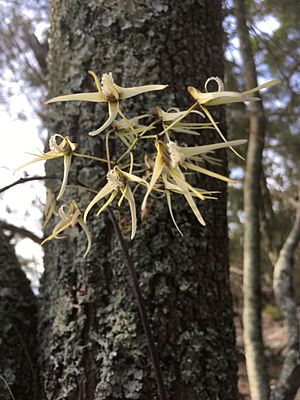Northern pencil orchid facts for kids
The Northern pencil orchid (Dendrobium teretifolium) is a special type of orchid. People also call it the thin pencil orchid, rat's tail orchid, or bridal veil orchid. This plant often grows on other plants (called an epiphyte) or on rocks (called a lithophyte).
It has long, thin stems that hang down. Its leaves look like pencils. The orchid also has stiff stems that hold its flowers. These stems can have up to twelve white or cream-colored flowers. You can find this orchid in rainforests and humid open forests. It mostly grows near the coast in New South Wales and Queensland, Australia.
Quick facts for kids Northern pencil orchid |
|
|---|---|
 |
|
| Dendrobium teretifolium growing on Casuarina glauca | |
| Scientific classification | |
| Genus: |
Dendrobium
|
| Species: |
teretifolium
|
What the Northern Pencil Orchid Looks Like
The Northern pencil orchid is a herb that grows on trees or rocks. It has stems that hang down and zig-zag. These stems can be from 0.5 to 2 meters (about 1.5 to 6.5 feet) long. They are about 2 to 4 millimeters (0.08 to 0.16 inches) wide. The stems form thick, bushy clumps.
Its leaves are shaped like cylinders. They hang down and can be very long, from 300 to 600 millimeters (about 1 to 2 feet). The leaves are 4 to 6 millimeters (0.16 to 0.24 inches) wide.
The orchid's flowering stems are 50 to 100 millimeters (about 2 to 4 inches) long. Each stem can hold 3 to 15 flowers. The flowers are white, cream-colored, or greenish. They are crowded together on the stem.
Each flower is 20 to 30 millimeters (0.8 to 1.2 inches) long. They are also 30 to 40 millimeters (1.2 to 1.6 inches) wide. The center of the flower often has red or purplish marks.
The sepals are like small leaves that protect the flower. They are 20 to 30 millimeters long and about 3 millimeters wide. They spread out widely. The petals are similar in length but much thinner, about 1 millimeter wide.
The orchid has a special petal called a labellum. It is curved and about 20 to 30 millimeters long. It is also about 5 millimeters wide. The labellum has three parts, called lobes. The side lobes curve upwards. The middle lobe has a long, thin tip. Its edges are crinkled. There are also three wavy lines on top of this middle lobe.
This orchid usually blooms in July and August.
Naming the Northern Pencil Orchid
The scientific name for this orchid is Dendrobium teretifolium. It was first officially described in 1810. A botanist named Robert Brown wrote about it. His description was published in a book called Prodromus Florae Novae Hollandiae et Insulae Van Diemen.
The second part of its scientific name, teretifolium, comes from two Latin words. Teres means "rounded." Folium means "a leaf." So, teretifolium describes its rounded, pencil-like leaves.
Where the Northern Pencil Orchid Lives
The thin pencil orchid can grow on rocks. However, it usually prefers to grow on trees. In Queensland, it often grows on hoop pine trees (Araucaria cunninghamii). In New South Wales, it likes to grow on Casuarina glauca trees.
You can find this orchid along the coast and in nearby mountain ranges. Its range stretches from near Calliope in Queensland down to Bega in New South Wales. It lives in rainforests, next to streams, and near mangrove swamps.

